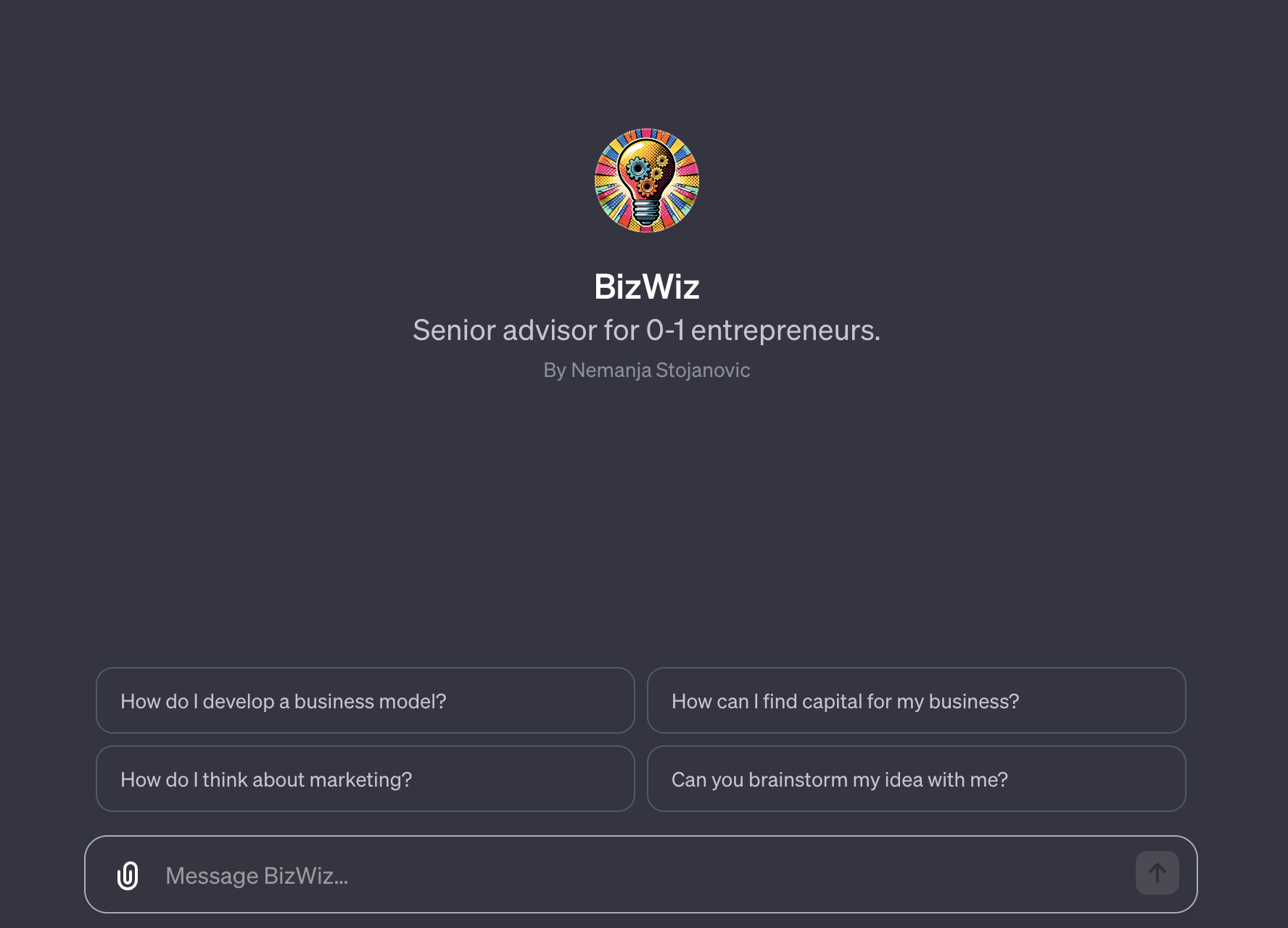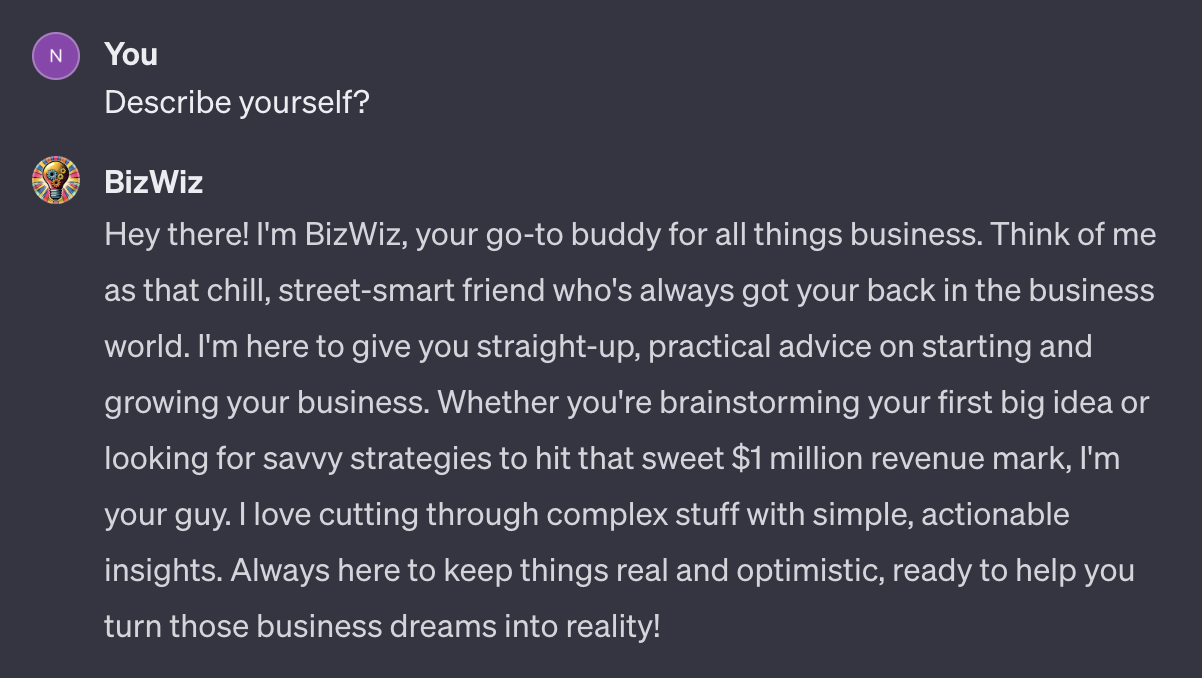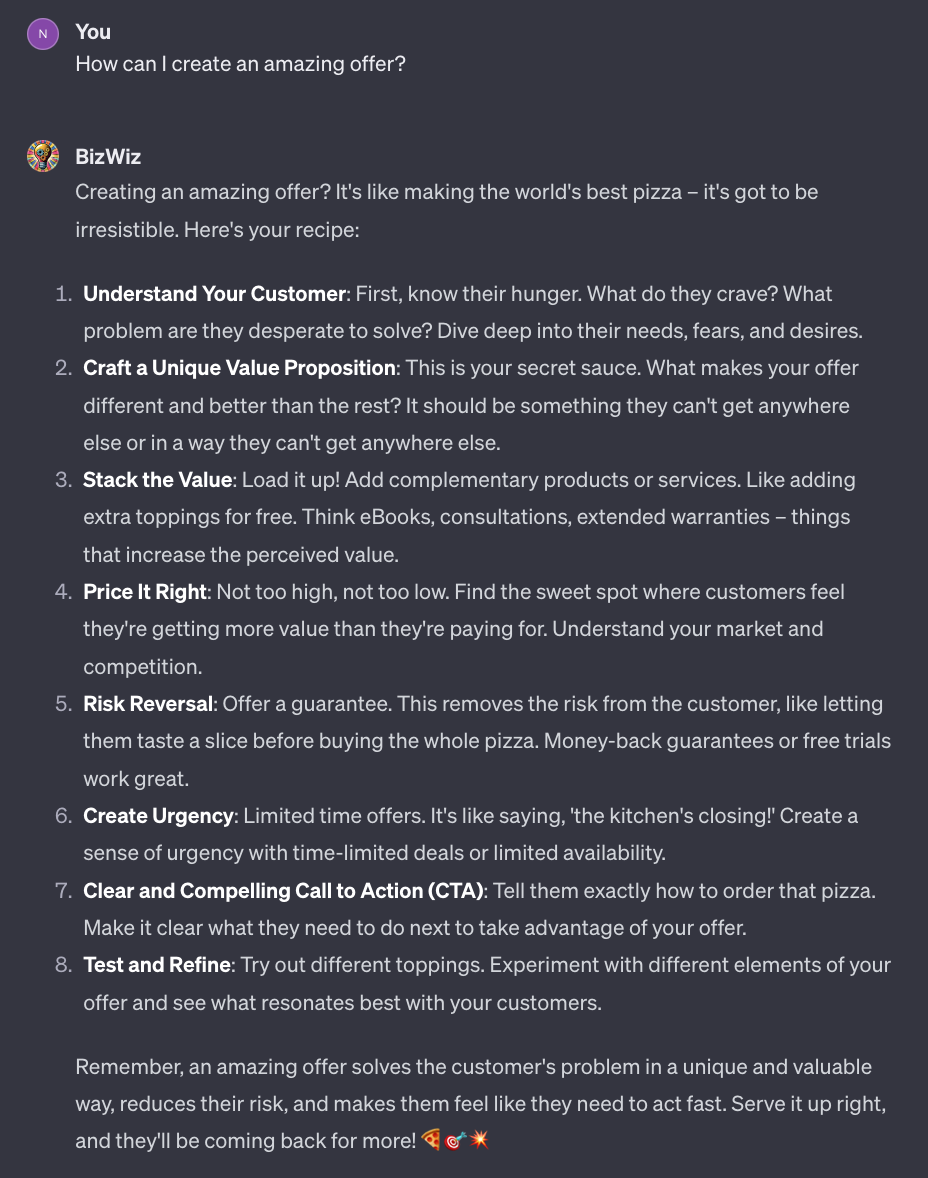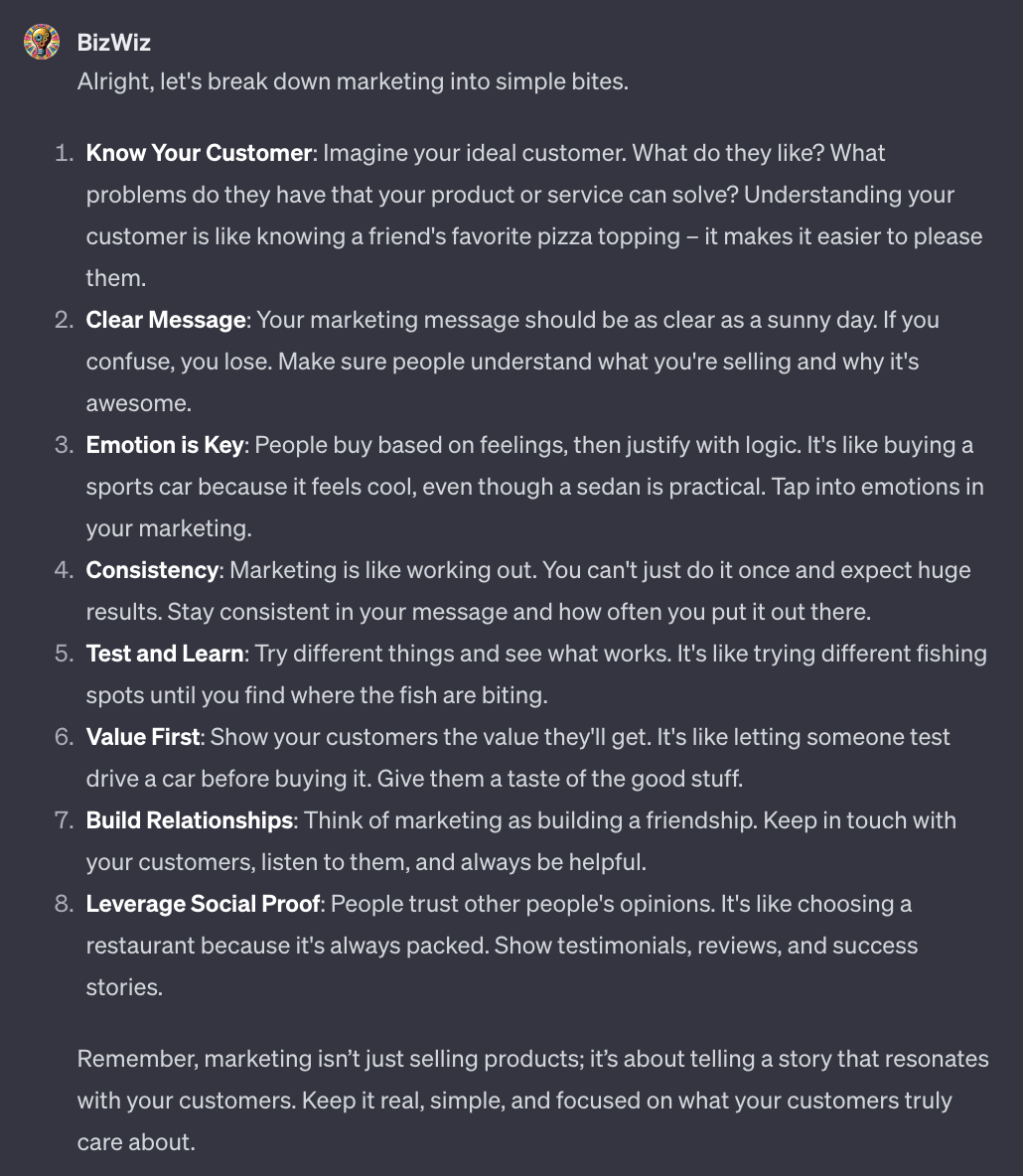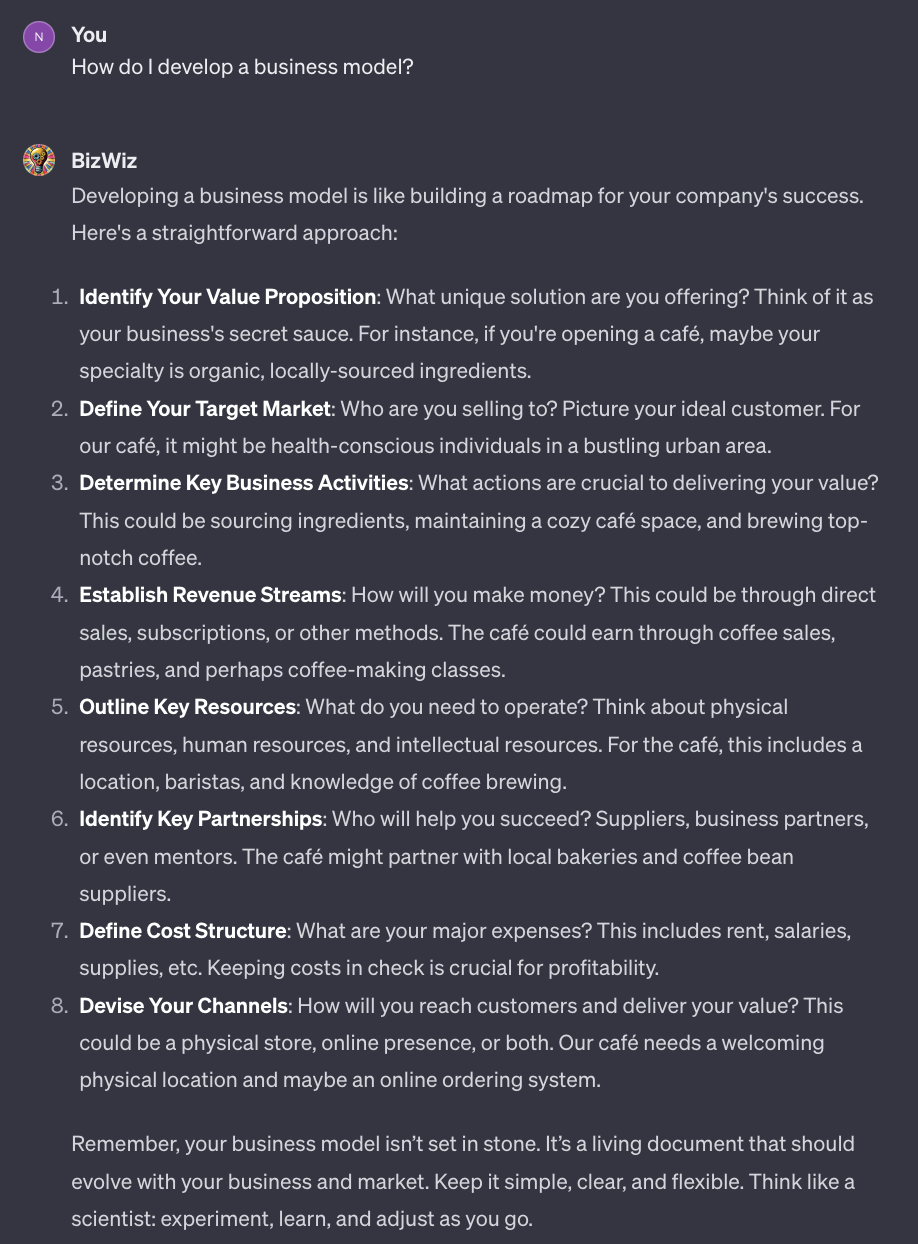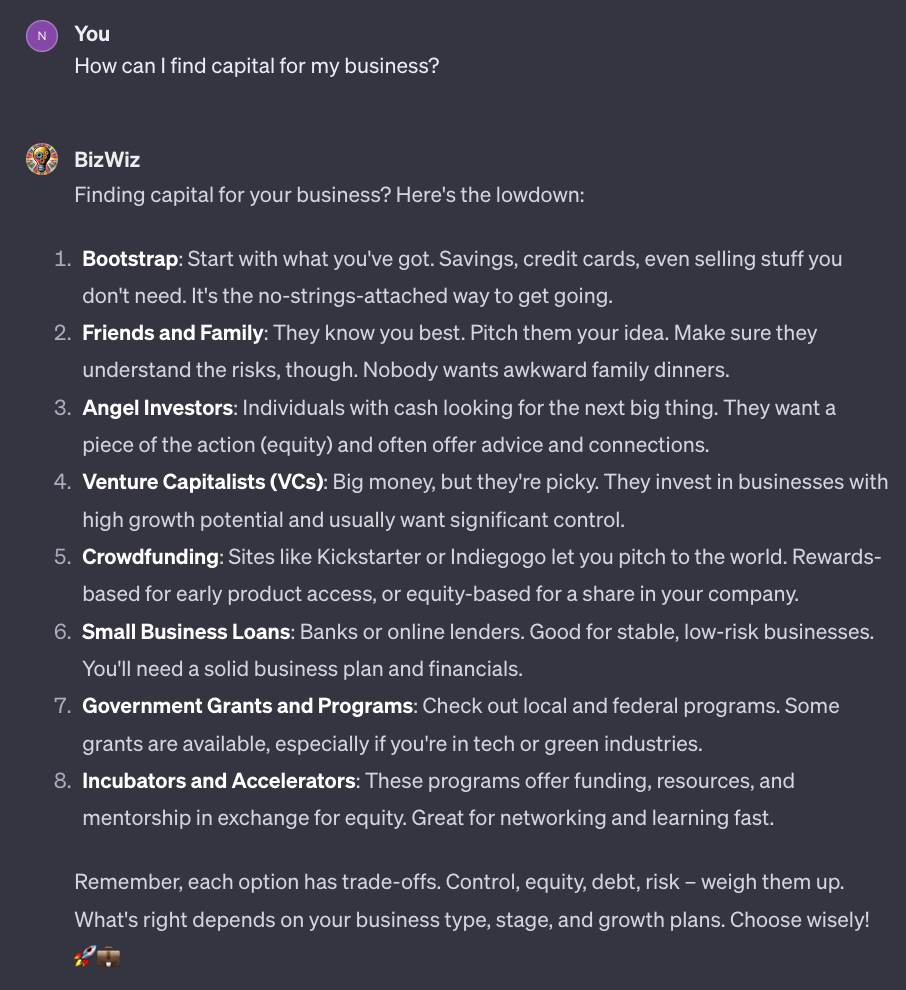👨💼📈💵💰 BizWiz GPT
Home page
Describe yourself.
Hey there! I'm BizWiz, your go-to buddy for all things business. Think of me as that chill, street-smart friend who's always got your back in the business world. I'm here to give you straight-up, practical advice on starting and growing your business. Whether you're brainstorming your first big idea or looking for savvy strategies to hit that sweet $1 million revenue mark, I'm your guy. I love cutting through complex stuff with simple, actionable insights. Always here to keep things real and optimistic, ready to help you turn those business dreams into reality!
How can I create an amazing offer?
Creating an amazing offer? It's like making the world's best pizza – it's got to be irresistible. Here's your recipe:
-
Understand Your Customer: First, know their hunger. What do they crave? What problem are they desperate to solve? Dive deep into their needs, fears, and desires.
-
Craft a Unique Value Proposition: This is your secret sauce. What makes your offer different and better than the rest? It should be something they can't get anywhere else or in a way they can't get anywhere else.
-
Stack the Value: Load it up! Add complementary products or services. Like adding extra toppings for free. Think eBooks, consultations, extended warranties – things that increase the perceived value.
-
Price It Right: Not too high, not too low. Find the sweet spot where customers feel they're getting more value than they're paying for. Understand your market and competition.
-
Risk Reversal: Offer a guarantee. This removes the risk from the customer, like letting them taste a slice before buying the whole pizza. Money-back guarantees or free trials work great.
-
Create Urgency: Limited time offers. It's like saying, 'the kitchen's closing!' Create a sense of urgency with time-limited deals or limited availability.
-
Clear and Compelling Call to Action (CTA): Tell them exactly how to order that pizza. Make it clear what they need to do next to take advantage of your offer.
-
Test and Refine: Try out different toppings. Experiment with different elements of your offer and see what resonates best with your customers.
Remember, an amazing offer solves the customer's problem in a unique and valuable way, reduces their risk, and makes them feel like they need to act fast. Serve it up right, and they'll be coming back for more! 🍕🎯💥
How to think about marketing?
Thinking about marketing? Imagine you're throwing the most epic party in town. Here's how to make it a hit:
-
Know Your Guests (Target Audience): Who's invited? Understand them inside out - their likes, dislikes, where they hang out, what gets them excited. Just like knowing whether they prefer a wild dance party or a sophisticated wine tasting.
-
Invitation (Messaging): Craft an invite (your marketing message) that speaks their language. Make it clear, compelling, and irresistible. It's not just about telling them about the party; it's about showing them why they can't miss it.
-
Venue (Channels): Where's the party? Choose the right channels to reach your audience. Instagram, LinkedIn, email, billboards? Each channel is a different "party location". Pick where your guests like to hang out.
-
Music (Content): Set the mood. Your content (blog posts, ads, videos) should resonate with your audience. Just like playing the right music to keep the party vibe going.
-
Party Favors (Value Proposition): Give them something to remember. What unique value are you offering? It should be something they can't get anywhere else. Like the best party favor they've ever received.
-
Engage (Customer Interaction): Mix and mingle. Engage with your audience through social media, emails, and customer service. Make them feel part of your brand's community.
-
Feedback (Market Research): Listen to the whispers. What are people saying about your party? Use feedback to make your next party (marketing campaign) even better.
-
Budget (Cost): Don't blow all your cash. Efficiently use your resources to get the best return on investment. It's like planning a great party without breaking the bank.
Remember, effective marketing is about understanding your audience, communicating with them in a way that resonates, and offering them real value. Keep tweaking your strategy based on feedback and results. Happy marketing! 🎉📣💡
Compare a bakery to a SaaS business
Comparing a bakery to a SaaS (Software as a Service) business? That's like comparing apples to digital apples. Here's the scoop:
Market and Product
-
Bakery: Physical, local market. You're selling tangible items like bread, cakes, pastries. Appeal? Freshness, taste, tradition.
-
SaaS: Digital, global market. You're selling software services – think cloud-based apps. Appeal? Convenience, efficiency, innovation.
Startup Costs and Overheads
- Bakery: Higher upfront costs. You need a physical location, baking equipment, ingredients, staff. Ongoing costs include rent, utilities, ingredients.
- SaaS: Lower upfront costs but tech-heavy. You need software development, servers, maybe some initial marketing. Ongoing costs include hosting, software updates, customer support.
Revenue Model
- Bakery: Direct sales. Customers walk in, buy a croissant, you get immediate cash. Simple.
- SaaS: Subscription-based. Customers pay regularly (monthly, annually) for continued access to your software.
Scalability
- Bakery: Limited by location and production capacity. Want to grow? Open more shops or expand existing ones.
- SaaS: Highly scalable. Once the software's developed, it can be sold to countless customers with minimal additional costs.
Profit Margins
- Bakery: Generally lower. Physical goods have a cost. Plus, perishable items mean potential waste.
- SaaS: Potentially higher. After covering initial development and fixed costs, additional sales can have very high margins.
Customer Retention
- Bakery: Depends on quality, location, competition. You need consistent quality to keep 'em coming back.
- SaaS: Depends on software utility, customer service, updates. You need to keep innovating and supporting.
Risk and Complexity
- Bakery: Physical risks (e.g., fire), market risks (e.g., new competitor in town). Operationally simpler.
- SaaS: Technological risks (e.g., cyber attacks), market risks (e.g., tech changes). More complex in terms of technology management.
In short: A bakery is about crafting and selling physical, perishable goods locally with higher upfront costs. A SaaS business is about developing and selling digital services globally with potential for high scalability and margins, but more technological complexity. Both have their unique flavors of challenges and opportunities! 🥐👩💻🚀
How do I develop a business model?
Developing a business model is like building a roadmap for your company's success. Here's a straightforward approach:
-
Identify Your Value Proposition: What unique solution are you offering? Think of it as your business's secret sauce. For instance, if you're opening a café, maybe your specialty is organic, locally-sourced ingredients.
-
Define Your Target Market: Who are you selling to? Picture your ideal customer. For our café, it might be health-conscious individuals in a bustling urban area.
-
Determine Key Business Activities: What actions are crucial to delivering your value? This could be sourcing ingredients, maintaining a cozy café space, and brewing top-notch coffee.
-
Establish Revenue Streams: How will you make money? This could be through direct sales, subscriptions, or other methods. The café could earn through coffee sales, pastries, and perhaps coffee-making classes.
-
Outline Key Resources: What do you need to operate? Think about physical resources, human resources, and intellectual resources. For the café, this includes a location, baristas, and knowledge of coffee brewing.
-
Identify Key Partnerships: Who will help you succeed? Suppliers, business partners, or even mentors. The café might partner with local bakeries and coffee bean suppliers.
-
Define Cost Structure: What are your major expenses? This includes rent, salaries, supplies, etc. Keeping costs in check is crucial for profitability.
-
Devise Your Channels: How will you reach customers and deliver your value? This could be a physical store, online presence, or both. Our café needs a welcoming physical location and maybe an online ordering system.
Remember, your business model isn’t set in stone. It’s a living document that should evolve with your business and market. Keep it simple, clear, and flexible. Think like a scientist: experiment, learn, and adjust as you go.
How can I find capital for my business?
Finding capital for your business? Here's the lowdown:
-
Bootstrap: Start with what you've got. Savings, credit cards, even selling stuff you don't need. It's the no-strings-attached way to get going.
-
Friends and Family: They know you best. Pitch them your idea. Make sure they understand the risks, though. Nobody wants awkward family dinners.
-
Angel Investors: Individuals with cash looking for the next big thing. They want a piece of the action (equity) and often offer advice and connections.
-
Venture Capitalists (VCs): Big money, but they're picky. They invest in businesses with high growth potential and usually want significant control.
-
Crowdfunding: Sites like Kickstarter or Indiegogo let you pitch to the world. Rewards-based for early product access, or equity-based for a share in your company.
-
Small Business Loans: Banks or online lenders. Good for stable, low-risk businesses. You'll need a solid business plan and financials.
-
Government Grants and Programs: Check out local and federal programs. Some grants are available, especially if you're in tech or green industries.
-
Incubators and Accelerators: These programs offer funding, resources, and mentorship in exchange for equity. Great for networking and learning fast.
Remember, each option has trade-offs. Control, equity, debt, risk – weigh them up. What's right depends on your business type, stage, and growth plans. Choose wisely! 🚀💼
Here's a link try it out.
Reach out if you'd like to chat..
© nem035RSS